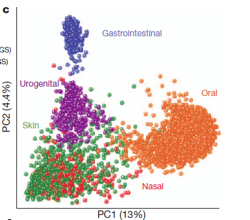
Today, in two of the world’s top medical journals, scientists are publishing the results of a $173 million government-funded project to sequence the vast bulk of bacteria, fungi, and viruses in and on the human body.
The results might at first seem anticlimactic. There’s no news about which germs cause or prevent disease, or even a clear message about how they make people different from one another. What we know is there are a lot of them. We have ten times as many microbial cells in our body as human ones, and though they are tiny, that still means that a 200-pound man is carrying two to six pounds of microbes, mostly bacteria. And there are tantalizing hints that they might play a role in all sorts of diseases. Patients who are at risk for difficult-to-treat hospital infections might have a particular kind of bacteria in their digestive systems; those who are obese might have another; children who can’t get enough nutrition might have a third.
